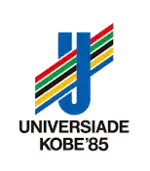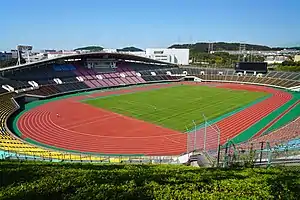1985 Summer Universiade
The 1985 Summer Universiade, also known as the XIII Summer Universiade, took place in Kobe, Japan.
 | |
| Host city | Kobe, Japan |
|---|---|
| Nations participating | 106 |
| Athletes participating | 2,783 |
| Events | 11 sports |
| Opening ceremony | August 24 |
| Closing ceremony | September 4 |
| Officially opened by | Crown Prince Akihito |
| Main venue | Kobe Universiade Memorial Stadium |
Mascot
The mascot of the Kobe Universiade, "Unitan", designed by Osamu Tezuka, is a red-crested white crane, symbolic of Japan and a good omen. The name was chosen from some 8,000 suggestions received from throughout the country. The name is derived from a combination of 'uni' from 'Universiade' and 'tan' from the Japanese name for red-crested crane, namely 'tancho-tsuru'.
Gender test
The sex chromatin test was used at these games to decide on participants' gender; Spanish hurdler Maria José Martínez-Patiño was declared a man and thus ruled ineligible for the women's events.[1][2][3] In agreement with officials who suggested she fake an injury so she could withdraw without publicity, she complied. She later fought, successfully, to have that diagnosis reversed.[4]
Sports
 Athletics ()
Athletics ()  Basketball ()
Basketball ()  Diving ()
Diving ()  Fencing ()
Fencing ()  Football ()
Football () _pictogram.svg.png.webp) Gymnastics ()
Gymnastics ()  Judo ()
Judo ()  Swimming ()
Swimming ()  Tennis ()
Tennis () _pictogram.svg.png.webp) Volleyball ()
Volleyball ()  Water polo ()
Water polo ()
Medal table
* Host nation (Japan)
| Rank | Nation | Gold | Silver | Bronze | Total |
|---|---|---|---|---|---|
| 1 | 42 | 23 | 18 | 83 | |
| 2 | 24 | 21 | 23 | 68 | |
| 3 | 9 | 8 | 5 | 22 | |
| 4 | 6 | 7 | 6 | 19 | |
| 5 | 5 | 10 | 6 | 21 | |
| 6 | 5 | 3 | 7 | 15 | |
| 7 | 4 | 6 | 5 | 15 | |
| 8 | 3 | 2 | 3 | 8 | |
| 9 | 3 | 1 | 4 | 8 | |
| 3 | 1 | 4 | 8 | ||
| 11 | 3 | 1 | 2 | 6 | |
| 12 | 2 | 6 | 4 | 12 | |
| 13 | 2 | 5 | 9 | 16 | |
| 14 | 2 | 4 | 2 | 8 | |
| 15 | 2 | 1 | 2 | 5 | |
| 16 | 1 | 4 | 3 | 8 | |
| 17 | 1 | 2 | 3 | 6 | |
| 18 | 1 | 2 | 2 | 5 | |
| 19 | 1 | 0 | 2 | 3 | |
| 20 | 1 | 0 | 1 | 2 | |
| 21 | 0 | 6 | 7 | 13 | |
| 22 | 0 | 4 | 3 | 7 | |
| 23 | 0 | 1 | 2 | 3 | |
| 24 | 0 | 1 | 0 | 1 | |
| 0 | 1 | 0 | 1 | ||
| 0 | 1 | 0 | 1 | ||
| 0 | 1 | 0 | 1 | ||
| 28 | 0 | 0 | 1 | 1 | |
| 0 | 0 | 1 | 1 | ||
| Totals (29 nations) | 120 | 122 | 125 | 367 | |
References
- Ruth Padawer (June 28, 2016). "The Humiliating Practice of Sex-Testing Female Athletes". The New York Times.
- Ljungqvist, A. (2008-04-15). "Gender Verification". In Barbara L. Drinkwater (ed.). The Encyclopaedia of Sports Medicine: An IOC Medical Commission Publication, Women in Sport. John Wiley & Sons. pp. 183–93. ISBN 9780470756850. Retrieved 2 March 2015.
- Schultz, Jaime (2014). Qualifying Times: Points of Change in U.S. Women's Sport. U of Illinois P. pp. 111–12. ISBN 9780252095962.
- Cole, Cheryl L. (2000). "One Chromosome Too Many?". In Kay Schaffer (ed.). The Olympics at the Millennium: Power, Politics, and the Games. Sidonie Smith. Rutgers UP. pp. 128–46. ISBN 9780813528205. Retrieved 2 March 2015.

